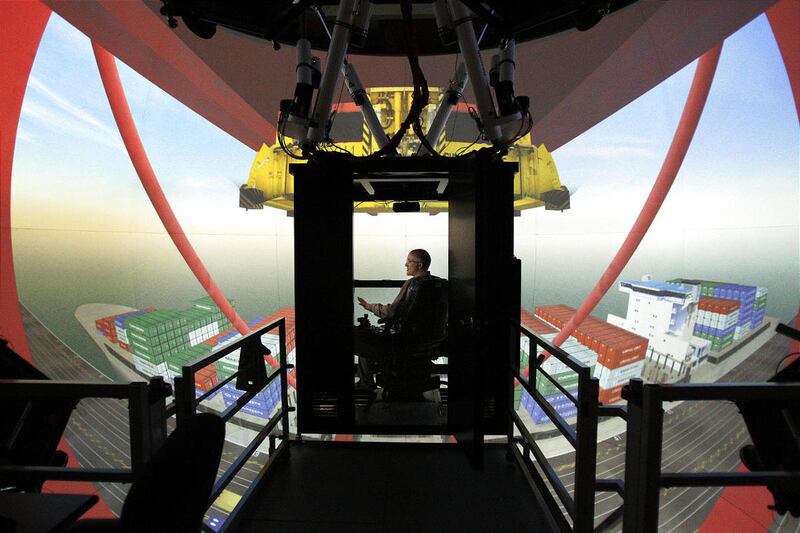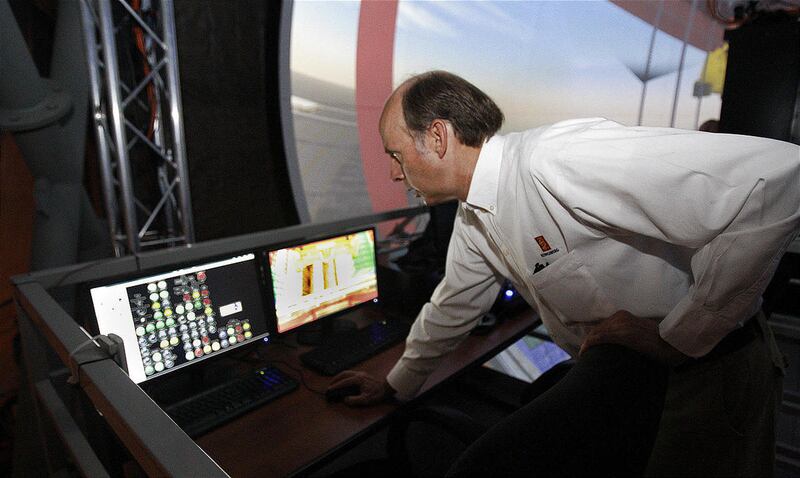PROVO —If the operator of the world's largest and most sophisticated harbor crane accidentally bumps a loaded container into a wall, the faux world around him or her shatters like glass, but no one dies.
"That's the beauty of simulation," said John Olsen, a lead engineer at Draper-based GlobalSim Inc., which constructs simulators to train maritime workers around the world.
"Something goes wrong. You goof. You die. We can bring you back to life with the push of a button."
With potential personal injury and structural damage, companies are turning to outfits such as GlobalSim to help workers get on-the-job training without jeopardizing on-the-job people. In early June, the company completed a $5 million harbor crane simulator, which it claims is the world's largest, for the Moroccan Port Authority.
Every year the construction industry has about 300 accidents and 150 deaths. People recognize the need to purchase and use simulators when there's an incident, said Clyde M. Stauffer IV, senior vice-president of marketing for GlobalSim
"We see a significant reduction in accidents and death rates, up to 95 percent accident reduction and a 20 percent decrease in fatalities and an increase in productivity," Stauffer said referring to a U.S. Army study when simulators are used.
"It's much safer to learn in a simulated, controlled environment."
Within the maritime simulator, a trainee operator can test drive a $5 million to $10 million harbor crane without having to worry about disastrous, expensive results as he or she learns to load and unload the thousands of 20- and 40-foot box containers carried by ship.
Simulators "absolutely" contribute to the safety of crane and heavy equipment operators, said Bob Dodge, vice-president of the Pacific Maritime Association, which trains union workers on the West Coast. The group operates simulators at two of its three training centers. The third is large enough to use actual equipment.
"While simulators are great, nothing beats the real thing," Dodge said, "But it's considerably more expensive to train on the real thing."
GlobalSim employs 29 people and records an average of $6.3 million in revenue annually. The company already has crane and maritime simulators in operation in Antwerp, Belgium, in France, in New York and other harbors. But the one geared for Morocco is the company's largest, Olsen said.
When port officials told GlobalSim what they wanted, company managers had to think hard and long about whether they could provide the product for the price offered. Five million sounds like a lot of money, but for the technology required, it's a bargain price, Stauffer said.
"It's always a challenge when you're pushing the technology," Olsen said. "When we bid it, we looked at their budget and what they wanted and decided we could do it if we were creative.
"That's what we do, GlobalSim builds advanced man-in-the-loop simulators, and anytime you have something like craning, something that involves large, complex, dangerous work, simulation is essential."
The company also builds training simulators for the airline industry, the military, the construction industry and a variety of special-order needs.
Some minor difficulties came while tackling the Moroccan project. To house the simulator and its 30-foot tall dome, the company rented an old steel fabrication plant in south Provo.
"It's kind of a technological marvel," Olsen said. "There is an awful lot of custom work here. You can't mass produce these."
The simulator took 10 months to construct. It includes a ship-to-shore gantry crane simulator, complete with detailed color graphics, 12 high-resolution projectors, swing motion loads, and it even shows the Hassan II mosque. The simulator is expected to be shipped this summer, once the port finishes its home building. The simulator will break down, filling 12 rail containers for shipping to the East Coast and then to Casablanca.
"This is the largest and most sophisticated crane and handling simulator in the world. The cab alone weighs 1,200 pounds," said Stauffer. "It'll take three to four weeks to disassemble, but it's designed to breakdown to panels that all bolt back together to create a seamless projected image that can be seen in real perspective."
GlobalSim was founded in 2003. Formerly the simulation division of Jason Associates Corp. of San Diego, several of the key employees, including Scott Huntsman, Joseph Frazier, Lynn Hancock and Stauffer, bought the assets and technology to create GlobalSim.
"We had a vision of the effectiveness of simulation for both safety and operational improvement training and mortgaged our houses to pursue the idea," Stauffer said. GlobalSim grew for about five years before Norway-based Kongsberg Maritime bought the company in 2008 for $20 million.
"Since Kongsberg Maritime is a worldwide company, the acquisition has opened up a significantly larger marketplace for GlobalSim and is providing us with many more customer connections and opportunities," said Stauffer.
"We don't have to use our homes as collateral any longer."
GlobalSim has developed and sold more than 145 crane and material handling equipment training systems to a variety of domestic and international customers, including training systems for military, port, maritime, construction and industrial operations.
Stauffer said generally the simulators are welcomed by longshoreman and union officials because they help create safer working conditions and streamline the training process.
Sharon Haddock is a professional writer with 30 years experience, 17 at the Deseret News. Her personal blog is at sharonhaddock.blogspot.com. Email: haddoc@desnews.com





